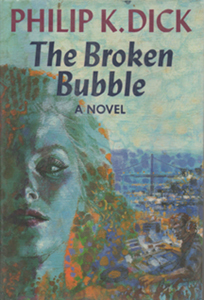“The Broken Bubble” (written in 1956, published in 1988) isn’t a science fiction novel, but it is a predictive novel from Philip K. Dick. Jim and Patricia, ex-spouses around age 30 who still like each other, and newlywed teenagers Art and Rachael, are drawn to each other as couples and as individuals. PKD’s later, safer story of an older couple wanting to befriend a younger couple, “Confessions of a Crap Artist,” would be the only one of his realist novels published in his lifetime.
Proto-swingers
“The Broken Bubble” is the racier piece, as it predicts the swinger lifestyle of two decades hence, although none of these four people could come close to imagining such a lifestyle – and maybe PKD himself is stumbling upon the idea by accident. Instead, all of these 1956 San Francisco folks are driven by raw magnetic attraction, even as their logical faculties lead them to different conclusions.
Additionally, in a bizarre and arguably unnecessary side plot, PKD writes about a man named Grimmelman who is trying to hide out from military draft officials. PKD obviously didn’t invent this idea, as US male citizens were drafted into war in the 1950s, but the idea of trying to avoid the draft was normalized a decade later with the Vietnam War.

“The Broken Bubble” (1988)
Composition year: 1956
Author: Philip K. Dick
Genre: Romantic drama
Setting: 1956, San Francisco
San Francisco plays differently here than in the other realist novels. Art and Rachael live in a shoddy basement apartment (recycled from one of Stuart’s abodes in “Voices from the Street”), but they have everything they need within walking distance.
The pseudo-couples (Art-Patricia and Rachael-Jim) try out domestic situations such as making dinner and shopping for clothes and going out for drinks. Interestingly, there isn’t a serious sense of jealousy-based drama, even though these are not open relationships and threats of violence loom.
Married too young
Rachael and Art are a case study in getting married too young, from both of their perspectives. PKD nicely introduces their youth with Jim’s shocked reaction that they are married when he hangs out with these two young fans after one of his radio broadcasts.
Jim is the DJ for the teen rock and roll show “Club 17.” (Later in the book, the radio personnel assume rock has run its course with Elvis, a line that would play as a delicious bit of irony only a few years later when the Beatles hit — and of course in 1988 when people finally got a chance to read “The Broken Bubble.”)
Art needs to sow his oats more, so he hooks up with Patricia; and Rachael desires a man rather than a boy as a husband, so she eyes Jim. Patricia – who can’t have a baby with the sterile Jim – wants to take care of Art, like he’s a child. Jim, also wishing he could have a kid, desires to care for both Art and Rachael.

The older couple recognizes the wrongness of their thoughts and actions. In that classic PKD fashion, they voice their conflicting perspectives in rapid succession. Patricia informs Art that it’s wrong that she should be buying clothes for him and teaching him how to dress; soon after, she does exactly that.
Internal contradictions
“The Broken Bubble” revels in people’s internal contradictions. Art is a sex fiend when he gains access to Patricia, yet he is completely conservative and shy about such topics in the daylight. For her part, after initially holding off Art’s advances, Patricia finally gives in, not long after he hits her in the eye.
It’s technically consensual, but it’s certainly uncomfortable to read. The details aren’t there like in a romance novel, but one can fill in the blanks as Patricia is sore for days after her night with Art. Suffice it to say that this is as close as PKD’s catalog gets to “Fifty Shades of Grey.”
Adding to the sexual deviancy, Patricia admits attraction to Rachael. But this is the 1950s, so PKD doesn’t go further than that. If he was writing this a few decades later, he might have.
While “The Broken Bubble” is not a science fiction novel, it does have SF writing within it. One of Art’s friends, Ferde (who is likewise part of the tinfoil hat group with Grimmelman), writes a short story called “The Peeping Man” that he is going to submit to an SF magazine – something PKD was himself doing at this time. It’s kind of like “The Golden Man,” and PKD uses the phrase “homo superior” a few years before “X-Men” debuted (although he didn’t invent the term).
One sci-fi element
Additionally, there arguably is a SF element in the narrative itself, because Grimmelman puts remote-control capability into a Horch, a large German car. He plays a class-divide protest prank on some rich kids by using the remote control.
It can be debated whether PKD took SF less seriously than his realist novels, but the (purposely) tossed-off quality of “The Peeping Man” gives me the sense that he saw SF as silly, fun and easy, whereas his more serious efforts were put into his non-SF novels.
In “The Broken Bubble,” PKD’s most serious efforts are put into the core quartet, and the peripheral elements don’t tie in like they should. The incessant advertising of Looney Luke’s car lot bookends the novel, and it’s the catalyst for Jim being suspended from his job, but I’m not sure of the thematic point.
Grimmelman is doing his vague conspiracy theorizing, but it doesn’t ring true that Art is/was in his sphere; Art is a socially awkward stutterer, but he shows none of the SF interest that his friends do. It might be a case where he has mentally, but not yet physically, left behind his former friends.
Weirdest of all is the subplot about an optometrists’ convention. Their connection to the main characters is tenuous, as they are linked through Bob, an ad salesman at the radio station. The book’s title comes from this subplot, and it adds more of the weird sex element: The convention’s not-exactly-legal entertainment is a nude woman inside a clear plastic bubble whom the doctors can kick around. The woman is bruised an annoyed by the end, even though this is within the bounds of the act.
Reality can’t compete with fantasy
“The Broken Bubble” is in part a commentary on bottled-up sexual urges. But I think it’s more about crushes and/or love, as Art, Jim, Rachael and Patricia think in terms of social acceptance and logic even though their feelings lead them to do what’s “wrong.” They might choose to do things differently in a world with more relaxed laws and mores. But then again, they might not; they aren’t “settling” for the person they are with; some of them are in love with multiple people.
None are precisely in love with themselves, though; as PKD characters, they can’t be. Patricia fantasizes about how good she’d look on Art’s arm once she makes him presentable, yet she’s the most suicidal of the foursome. Art hates his own guts, yet he also cares more about saving his own skin than sparing other people’s feelings.
The four leads are so well drawn that, in retrospect, the side plots hurt the novel’s focus. PKD might’ve been going for a commentary on the world’s randomness, and this might’ve worked if Ferde — who is in love with Rachael from afar — somehow ended up with her. As it stands, the “randomness” idea doesn’t fit since the relationship pairings and potential pairings – while emotionally driven – are not random. They are exhaustively thought out, both internally and externally.
PKD definitely crams too much into the margins of this novel, but “The Broken Bubble” has a solid center. And as one of only nine realist novels from PKD, it should be treasured despite its weaknesses.

